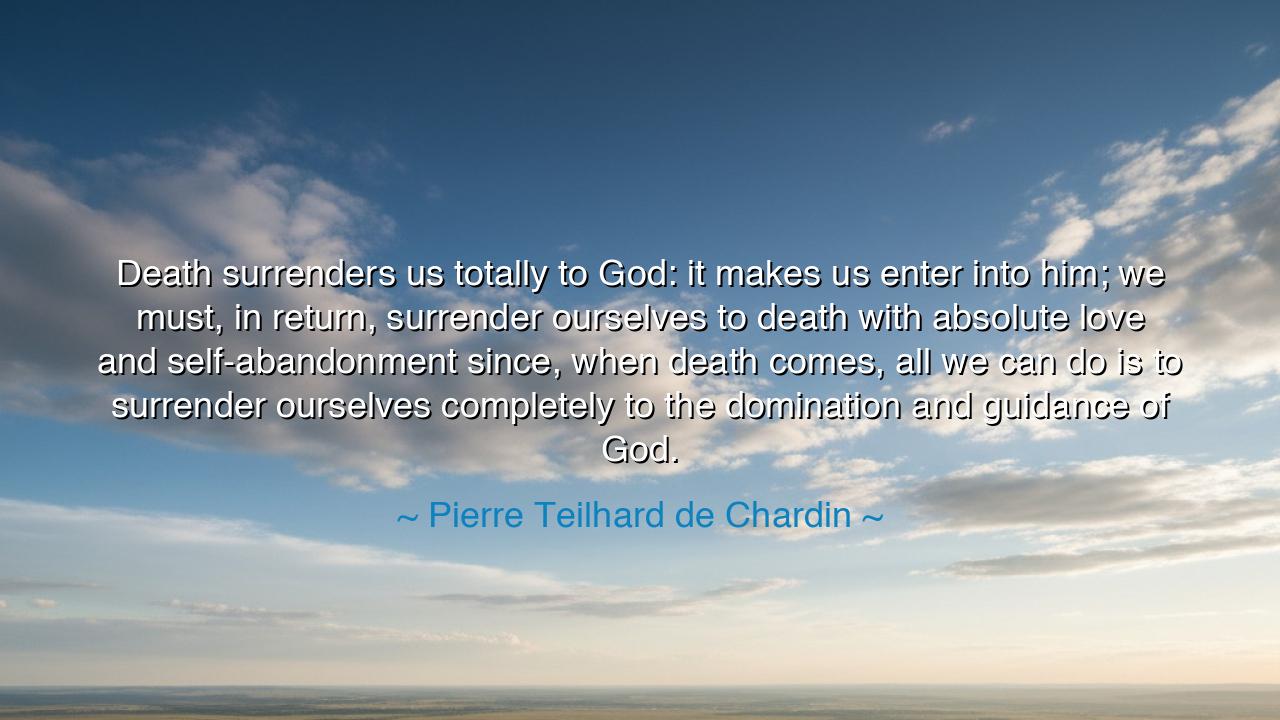
Death surrenders us totally to God: it makes us enter into him;
Death surrenders us totally to God: it makes us enter into him; we must, in return, surrender ourselves to death with absolute love and self-abandonment since, when death comes, all we can do is to surrender ourselves completely to the domination and guidance of God.






“Death surrenders us totally to God: it makes us enter into him; we must, in return, surrender ourselves to death with absolute love and self-abandonment since, when death comes, all we can do is to surrender ourselves completely to the domination and guidance of God.” Thus wrote Pierre Teilhard de Chardin, the Jesuit priest, paleontologist, and mystic whose words bridge the vastness of science and the fire of faith. In these lines, he does not speak of death as an ending, but as a transformation—a sacred passage from the fragmentary to the infinite. He calls us not to resist the inevitable, but to embrace it with love, to yield not in terror, but in trust. His vision is both mystical and courageous: that in our final surrender, we are not defeated, but fulfilled, as the drop returning to the ocean.
Teilhard lived in an age where faith and science seemed divided by an abyss, yet he sought to unite them in a single cosmic understanding. For him, all life was moving toward what he called the Omega Point—the final convergence of creation into the divine. Death, then, was not a failure of life, but its completion, the moment when the soul, freed from the body’s limits, is drawn into the wholeness of God. Thus, when he writes that “death surrenders us totally to God,” he means that mortality itself is the last act of creation—the moment when we cease to hold ourselves apart and are gathered fully into the Source from which all things spring.
Yet Teilhard does not speak of passive acceptance. He asks that we meet death with “absolute love and self-abandonment.” To him, surrender is not despair—it is the final act of trust. It is to say, “Here I am, take me as I am,” and to fall willingly into the hands of the Eternal. This is the same surrender that mystics across ages have spoken of—the yielding of the self not only in death, but in life. For each time we let go of pride, control, or fear, we practice a kind of dying, and through that, a kind of union with God. To surrender to death, therefore, is to live one’s whole life in preparation for that holy release—to learn the art of letting go.
Consider the story of Saint Francis of Assisi, who near his end called death his “sister.” In his final days, he sang praises to “Sister Death,” welcoming her not as an enemy, but as a messenger of reunion. Like Teilhard, Francis understood that death is not the end of the soul, but the beginning of its homecoming. His serenity came from a life of surrender—he had already renounced wealth, pride, and worldly power. So when the final moment arrived, it found him unafraid, already free. This, too, is Teilhard’s teaching: that when the heart has learned to yield in life, it will not tremble in death.
But many fear death precisely because they have never practiced surrender. They cling to possessions, to ambitions, to illusions of control. Teilhard’s words challenge this fear. He reminds us that death is not our enemy, but our teacher, revealing the truth that control was never truly ours to begin with. When he writes of “the domination and guidance of God,” he speaks not of a tyrant’s rule, but of divine order, the sacred rhythm that carries the stars and the seasons and, in time, our very souls. To resist that rhythm is to live in anxiety; to flow with it is to live in peace.
Teilhard’s understanding of death also mirrors the cycles of nature he studied as a scientist. In the forest, the fallen leaf enriches the soil; in the sea, the dying coral gives birth to new reefs. All things are part of a larger process of renewal. Death, therefore, is not destruction but integration—the moment when what was separate becomes whole again. Just as energy is never lost, but transformed, so the soul, in surrendering, is not extinguished but absorbed into the boundless life of God. To love death, then, is to recognize it as part of the divine order—a doorway, not a wall.
So, O child of the living and the dying, take this teaching to heart: learn to surrender before you are taken. Let each day be an offering—each act, a practice of trust. When you lose what you love, surrender it with gratitude. When your plans fail, release them without bitterness. For each surrender prepares the soul for its final return. Do not fear death, for it is not the abyss but the embrace of the Infinite.
And when your final hour comes—when the body grows still and the breath fades—remember Teilhard’s words. Let your heart say, “I surrender,” not as a cry of defeat, but as a song of reunion. For in that surrender, you will discover what he saw in his vision of the universe: that all creation is drawn upward into love, that death is not the end but the consummation of life, and that to abandon oneself utterly to God is not to vanish, but to become eternal.






AAdministratorAdministrator
Welcome, honored guests. Please leave a comment, we will respond soon